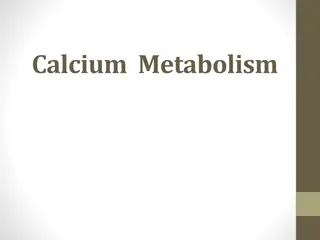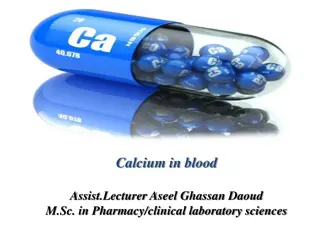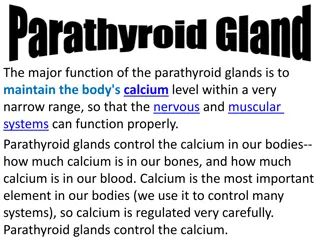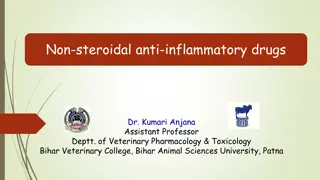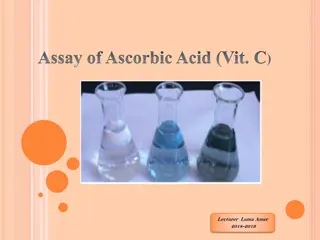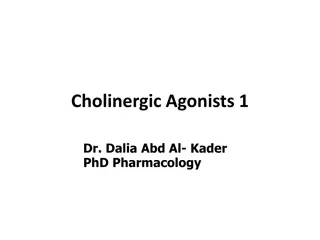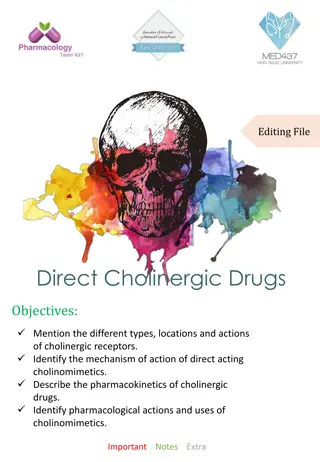Pharmacology of Drugs Used in Calcium & Vitamin D Disorders
Calcium and vitamin D play crucial roles in regulating bone health and overall calcium balance in the body. Hormones like PTH, vitamin D, and calcitonin are pivotal in maintaining calcium homeostasis. Drugs such as teriparatide, a synthetic form of PTH, are used to treat conditions like osteoporosis by stimulating bone formation. Understanding the mechanisms of action of these drugs is essential in managing calcium and vitamin D-related disorders effectively.
Download Presentation

Please find below an Image/Link to download the presentation.
The content on the website is provided AS IS for your information and personal use only. It may not be sold, licensed, or shared on other websites without obtaining consent from the author. Download presentation by click this link. If you encounter any issues during the download, it is possible that the publisher has removed the file from their server.
E N D
Presentation Transcript
Pharmacology of drugs used in calcium & vitamin D disorders Color index: Important Note Extra Editing File Editing File
Mind map Hormones used for osteoporosis PTH Vitamin D Calcitonin These three principal hormones regulate calcium homeostasis Drugs used for osteoporosis Note: PTH & Vitamin D have similar effects and calcitonin antagonizes those effects Although PTH & Calcitonin have antagonistic effects. They can both be used for the treatment of osteoporosis Teriparatide Introduction Calcium Metabolism Calcium plays an essential role in many cellular processes, including muscle contraction, hormone secretion, cell proliferation, and gene expression. Calcium balance is a dynamic process that reflects a balance between calcium absorption by the intestinal tract, calcium excretion by the kidney, and release and uptake of calcium by bone during bone formation and resorption. Three target tissues regulate calcium homeostasis: 1. Bone 2. Kidney 3. Intestine The dominant site of calcium storage in the body is bone, which contains nearly 99.9% of body calcium. Most body calcium is stored in bone (~1000 g), which is a very dynamic site as bone is remodeled continuously by resorption of old bone by osteoclasts & formation of new bone by osteoblasts Although only a small fraction of total body calcium is located in the plasma, it is the plasma concentration of ionized calcium that is tightly regulated, primarily under the control of PTH and vitamin D.
Parathyroid Hormone (Phosphate Trashing Hormone) PTH: A hormone that plays a critical role in controlling calcium, and phosphate balance. PTH is released from the parathyroid gland in response to low plasma Ca2+ level . The stimulus for parathyroid hormone (PTH) is hypocalcaemia . Secretion of PTH is inversely related to [Ca2+]. Definition The overall action of PTH is to increase plasma Ca2+ levels in response to hypocalcemia: 1. PTH enhances intestinal calcium absorption of calcium in the presence of permissive amounts of vitamin D. 2. PTH stimulates bone resorption by stimulating osteoclasts to increase the outward flux of calcium to restore serum calcium level. 3. PTH stimulates the active reabsorptionof calcium from the kidney increase formation of calcitriol which is the active form of vitamin D Action -Daily, intermittent administration of recombinant human PTH, SC in the thigh (alternate thigh every day ) leads to a net stimulation of bone formation for treatment of osteoporosis. (has an anabolic effect) so Decreases osteoclast activity -Continuous or chronic exposure to high serum PTH concentrations (as seen with primary or secondary hyperparathyroidism) results in bone resorption and risk of fractures, so we can use PTH for treatment but not continuously Intermittent: Osteoblast number/function, Bone formation, Bone mass/strength This is the desired effect that combats osteoporosis ( PTH is secreted intermittently, so we try to mimic the normal state) Continuous: Osteoclast, Bone resorption, Serum Ca2+ (this produces an effect similar to PTH secreting tumors) Response Treatment of severe osteoporosis Resistant cases failed to respond to other medications Uses
Teriparatide Synthetic polypeptide form of PTH (PTH analogue). It belongs to a class of anti-osteoporosis drugs, the so-called anabolic agents. (stimulates osteoblasts) Given, once daily by subcutaneous injection MOA Once-daily administration of teriparatide stimulates new bone formation by preferential stimulation of osteoblastic activity over osteoclastic activity. Therapeuti c effects By contrast, continuous administration of teriparatide , may be detrimental to the skeleton because bone resorption may be stimulated more than bone formation. Good for postmenopausal osteoporosis. For treatment of osteoporosis in people who have a risk of getting fracture (increases bone mass & strength) Used in severe osteoporosis or patients not responding to other drugs. Should not be used routinely due to carcinogenic effects. Uses Carcinogenic effect (osteosarcoma) Diarrhea, heartburn, nausea Headache, leg cramps Hypotension when standing (orthostatic hypotension) Elevated serum calcium which may occur in some cases can lead to kidney stones Adverse Effects Teriparatide should not be used by people with increased risk for bone tumors (osteosarcoma) including: People with Paget's disease of bone People who had radiation treatment involving bones Not recommended in children C.I.
Vitamin D Vitamin D is a steroid hormone that is intimately involved in the regulation of plasma calcium levels. Its role in calcium metabolism first was recognized in the childhood disease rickets, which is characterized by hypocalcemia and various skeletal abnormalities Definition Exposure to the ultraviolet rays in the sunlight convert 7DC to cholecalciferol. Vitamin D3 is metabolically inactive until it is hydroxylated in the liver then the kidney (by hydroxylase) to the active form 1,25 Dihydroxycholecalciferol Metabolism increases bone resorption increases Ca2+ absorption from intestine increases renal Ca2+ and PO4 reabsorption decreases the production of PTH by the parathyroid glands The overall effect is increased plasma calcium concentrations 1. 2. 3. 4. Calcium & Vitamin D Treatment of Vitamin D deficiency diseases: 1. 2. 3. Also used for: 1. 2. Rickets Osteomalacia Osteoporosis (postmenopausal women take vitamin d + calcium) Uses Psoriasis Prevention of Prostate & Colorectal Cancer Cholecalciferol (Vitamin D3) in skin Ergocalciferol (Vitamin D2) in plants Vit D2 and Vit D3 have equal biological activities. Vitamin D2 is the prescription form of vitamin D & is also used as food additive (milk). Vitamin D3 is usually for vitamin D- fortified milk & foods & also available in drug combination products. Sources 1,25-dihydroxyvitamin D (calcitriol) is the most active form of vitamin D. 25-hydroxyvitamin D (calcidiol, 25-hydroxycholecalciferol): an inactive form of vitamin D. 1-alpha-hydroxylase: The enzyme that converts the inactive form of vitamin D to the active form Remember
Calcitonin Calcitonin is synthesized and secreted by the parafollicular cells (C cells) of the thyroid gland. It is released when there is a rise in plasma Ca2+ levels While PTH and vitamin D act to increase plasma Ca2+, only calcitonin causes a decrease in plasma Ca2+ Calcitonin protects against development of hypercalcemia caused by a variety of conditions, including increased calcium absorption (milk-alkali syndrome) and decreased calcium excretion (thiazide use). MAS: excessive milk intake to treat peptic ulcer will lead to accumulation of calcium and alkaline alkalosis Definition The major effect of calcitonin administration is a rapid fall in Ca2+ (serum calcium ) caused by: 1. The osteoclast bone cells appear to be a particular target of calcitonin (key function of calcitonin) 2. increasing their excretion. Calcitonin does not appear to be critical for the regulation of calcium homeostasis even if thyroid gland is removed. Inhibiting bone resorption by inhibiting osteoclast activity. Action Decreasing reabsorption of Ca2+ & PO4 by the kidney, thus S.C., Nasal spray or solution (Calcitonin Salmon ) has more affinity towards human calcitonin receptors P.K Used clinically in treatment of hypercalcemia (biggest indication) and in certain bone diseases in which sustained reduction of osteoclastic resorption is therapeutically advantageous. Osteoporosis (major indication; alternative to other drugs). Hypercalcemia (short-term treatment of hypercalcemia of malignancy), Paget's disease. It has lower efficacy compared to other drugs. (it is not very effective clinically) Uses Nausea Local inflammation at site of injection (SC administration) Flushing of face & hands Nasal irritation ADRS
Parathyroid Hormone Parathyroid Hormone Vitamin D Vitamin D Definition: released from the parathyroid gland in response to low plasma Ca2+ level . Definition: a steroid hormone involved in the regulation of plasma calcium levels & increase its level. Response: given S.C Intermittent: Osteoblast number/function Bone formation Bone mass/strength Continuous: Osteoclast Bone resorption Serum Ca2+ Forms: Cholecalciferol (Vitamin D3) in skin Ergocalciferol (Vitamin D2) in plants Calcitriol 1,25-dihydroxyvitamin D is the active form Use: 1-Treatment of severe osteoporosis 2-Resistant cases failed to respond to other medications Deficiency leads to: Rickets , Osteomalacia, Osteoporosis Use: Rickets & Osteomalacia, Osteoporosis, Cancer prevention Calcitonin Calcitonin Teriparatide Teriparatide M.O.A: PTH analogue, anti-osteoporosis (anabolic) stimulate new bone formation if given intermittently If given continuously bone reabsorbtion Should be given intermitted not continuous Definition: secreted by (C cells) of the thyroid gland. released when there is a rise in plasma Ca2+ levels to its absorption Inhibit osteoclast activity inhibiting bone reabsorption. It has lower efficacy compared to the other drugs. Use: postmenopausal osteoporosis Should not be used routinely due to carcinogenic effects Routes of administration: S.C , Nasal spray or solution has more affinity towards human calcitonin receptors Contraindication: (osteosarcoma) Paget's disease, radiation treatment, children Use: Osteoporosis, Hypercalcemia of malignancy Paget's disease ADRs: Carcinogenic effect, lead to kidney stones ,orthostatic hypotension ADRs: 1-Local inflammation at site of injection 2-Flushing of face & hands 3-Nasal irritation
Questions Administration of parathyroid hormone must be: A. B. C. Continuous Continuous following a loading dose Intermittent Teriparatide is a: A. B. C. PTH synthetic analogue Calcitonin receptor antagonist Bisphosphonate Vitamin D s effect on the kidney: A. B. C. Decreases renal Ca2+ and PO4 reabsorption Increases renal Ca2+ and PO4 reabsorption increases renal Ca2+ absorption and decreases PO4 reabsorption A common adverse effect of teriparatide: A. B. C. D. Leukopenia Arthropathy Osteosarcoma Autoimmune hepatitis Which of the following is released in response to hypercalcemia A. B. C. PTH Vitamin D Calcitonin Answers: C - A - B - C - C A 50 year old woman visits her family physician and the physician prescribes her medication to prevent postmenopausal osteoporosis. She tells her this drug is a synthetic PTH analogue. 1-Name the drug the woman was prescribed: Teriparatide 2-List two possible adverse effects: Renal stones Osteosarcoma 3-List two hormones (other than PTH) that can be used to treat osteoporosis: Vitamin D Calcitonin
Team Leader: Majed Aljohani Layan AlMana Thanks for those who worked on the lectures : Abduljabbar Alyamani Notes by Alanoud Almansour Sultan Alnasser References: Doctors slides and notes @Pharma4370 Pharm437@gmail.com


